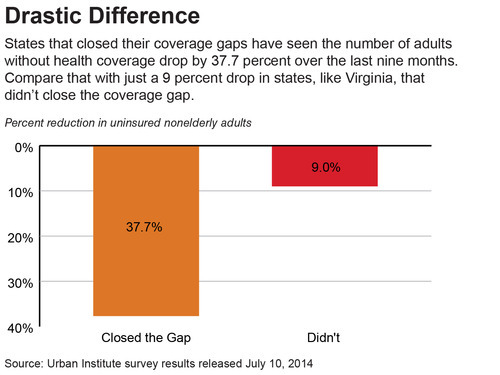July 22, 2014
Other States Benefit From Closing the Coverage Gap – But not Virginia
It’s becoming clearer every day that there is a stark and growing contrast between states that have closed their coverage gaps and those – like Virginia – that stubbornly hold out against accepting federal funds to cover their low-income residents.
In other states the number of people with health insurance is going way up. And the costs to hospitals of taking care of people who don’t have insurance are going down. But not in Virginia.
States that have closed their coverage gaps have seen nearly a 38 percent reduction in their nonelderly uninsured population in less than a year, according to a recent Urban Institute study. Compare that with the paltry 9 percent drop in states that continue to refuse the federal funding – like Virginia.

And people using their new health coverage to help pay for medical treatment are helping hospitals avoid bad debt. States that have said yes to expanding coverage saw drastic declines in charity care and people paying out of pocket, while intransigent states – like Virginia – saw no improvement, according to a hospital industry analysis. For example, Arizona hospitals have seen a 30 percent reduction in their uncompensated care, which translates to $76 million saved in just the first four months of this year.
That’s the sort of help that many hospitals – especially in rural areas – could use. Without closing the coverage gap, hospitals across Virginia will lose out on hundreds of millions of dollars to care for uninsured people. And without that money, many hospitals will be forced to make tough decisions about cutting staff, closing off units, or shuttering entire facilities, as happened in Lee County.
Today Mayor Adam O’Neal from Belhaven, NC is walking through Richmond on his way to Washington, D.C to highlight the plight of his town. Like in Lee County, the hospital in Belhaven closed and terminated about 100 jobs, largely because his state legislature has also refused to close the coverage gap.
There is no more if and when.
Right now, too many Virginians struggling to get by in a still-tough economy can’t afford the quality health care they need. And many hospitals, which often are the largest employers around, face significant challenges from bearing the costs when people without insurance show up at the emergency room. It is time to close the coverage gap, so people can get help paying for the care they need and hospitals can avoid painful layoffs that will only compound the problem.
–Massey Whorley, Senior Policy Analyst
